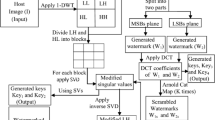Abstract
Traditional watermarking algorithms suffer from degradations in watermarked image during embedding phase and also bound by differing necessities like embedding capacity, robustness and transparency, these issues can be eliminated using zero watermarking. Zero watermarking facilitates reverse and blind watermark extraction features as it guarantees the integrity of the host image after embedding the watermark image. In this work two methods of zero watermarking algorithms for medical image authentication is proposed, discussions on the two methods one involving singular-value decomposition and the other using composite CT-SVD domain were presented. Experimentations were carried out using medical images. The proposed model best suits for healthcare institutions, as such the proposed scheme is highly resilient and robust against various attacks and facilitates in authenticating the medical images and also present additional information regarding clinical results to the radiologist remotely located. The comparison results show that the proposed method is more robust than further zero watermarking schemes.










Similar content being viewed by others
References
Liu, D., Zhang, J.: Case study of security in teleradiology reporting system for management of data from multiple enterprises. Int. J. Bus. Soc. Sci. 2(4), 9–15 (2011)
Al-Qershi, O.M., Khoo, B.E.: Authentication and data hiding using a hybrid ROI-based watermarking scheme for DICOM images. J. Digit. Imaging 24(1), 114–125 (2011)
Shu, Z., Wang, S., Deng, C., Liu, G., Zhang, L.: Water-marking algorithm based on Contourlet transform and human visual model. In: Proceedings of the International Conference on Embedded Software and Systems (ICESS ’08), pp. 348–352 (2008)
HL7 PID (Patient Identification) Segment: http://www.corepointhealth.com/resource-center/hl7-resour-ces/hl7-pid-segment (2012)
Song, H., Yu, S., Yang, X., Song, L., Wang, C.: Contourlet-based image adaptive watermarking. Signal Process. 23(3), 162–178 (2008)
Ganic, E., Eskicioglu, A.M.: Robust DWT-SVD domain image watermarking: embedding data in all frequencies. In: Proceedings of the International Multimedia Conference and Workshop on Multimedia and Security, 20, pp. 166–174 (2004)
Dong, C., Zhang, H., Li, J., Chen, Y.W.: Robust zero-watermarking for medical image based on DCT. In: Proceedings of IEEE 6th International Conference on Computer Sciences and Convergence Information Technology, pp. 900–904 (2011)
Wen, Q., Sun, T.-F., Wang, S.-X.: Concept and application of zero-watermark. Acta Electron. Sin. 31(2), 214–216 (2003)
Nyeem, H., Boles, W., Boyd, C.: A review of medical image watermarking requirements for teleradiology. J. Digit. Imaging 26(2), 1–18 (2012)
Narasimhulu, C.V., Prasad, K.S.: A new SVD based hybrid color image watermarking for copyright protection using contourlet transform. Int. J. Comput. Appl. 20(8), 18–27 (2011)
Zxing.: http://code.google.com/p/zxing/ (2012)
Garc’ıa-Betances, R.I., Huerta, M.K.: A review of automatic patient identification options for public health care centers with restricted budgets. Online J. Public Health Inform. 4(1), 1–16 (2012)
Seenivasagam, V., Velumani, R.: A QR code based zero watermarking scheme for authentication of medical images in teleradiology cloud. Comput. Math. Methods Med. 2013, 1–16 (2013)
Fan, T.Y., Chieu, B.C., Chao, H.C.: Robust copyright-protection scheme based on visual secret sharing and Bose–Chaudhuri–Hocquenghem code techniques. J. Electron. Imaging 21, 4 (2012)
Do, M.N., Vetterli, M.: The contourlet transform: an efficient directional multiresolution image representation. IEEE Trans. Image Process. 14(12), 2091–2106 (2005)
Zeng, F.J., Zhou, A.M.: Image zero-watermarking algorithm based on contourlet transform and singular value decomposition. J. Comput. Appl. 28(8), 2033–2035 (2008)
Hu, M.K.: Visual pattern recognition by moment invariants. IRE Trans. Inf. Theory 8(2), 179–187 (1962)
Rawat, S., Raman, B.: A blind watermarking algorithm based on fractional Fourier transform and visual cryptography. Signal Process. 92(6), 1480–1491 (2012)
Author information
Authors and Affiliations
Corresponding author
Rights and permissions
About this article
Cite this article
Kavitha, C., Sakthivel, S. An effective mechanism for medical images authentication using quick response code. Cluster Comput 22 (Suppl 2), 4375–4382 (2019). https://doi.org/10.1007/s10586-018-1905-9
Received:
Revised:
Accepted:
Published:
Issue Date:
DOI: https://doi.org/10.1007/s10586-018-1905-9




